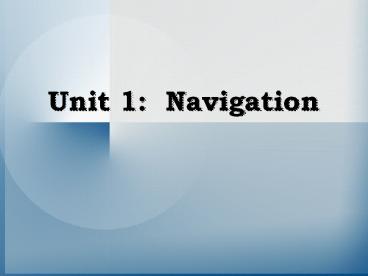Unit 1: Navigation - PowerPoint PPT Presentation
1 / 20
Title:
Unit 1: Navigation
Description:
1. Dead Reckoning (DR) the process of estimating your position by advancing a known position using course, speed, time and distance to be traveled. – PowerPoint PPT presentation
Number of Views:229
Avg rating:3.0/5.0
Title: Unit 1: Navigation
1
Unit 1 Navigation
2
What is Navigation?
- Navigation is the process of monitoring and
controlling the movement of a craft or vehicle
from one place to another - It involves
- Gathering information from sources
- Evaluating the information
- Making decisions based on the information
3
- Navigation techniques vary with the type of
vessel, conditions and the navigators experience - Navigation is both a science and an art that
takes knowledge, skill and practice
4
Types of Navigation
- There are 6 main types of navigation
- Dead Reckoning
- Piloting
- Celestial Navigation
- Radio Navigation
- Radar Navigation
- Satellite Navigation
5
1. Dead Reckoning (DR)
- the process of estimating your position by
advancing a known position using course, speed,
time and distance to be traveled.
In other words figuring out where you will be at
a certain time if you hold the speed, time and
course you plan to travel.
6
2. Piloting
- Piloting involves navigating in restricted waters
with frequent determination of position relative
to geographic and hydrographic features. - This method is used when in sight of land
7
3. Celestial Navigation
- uses "sights," or angular measurements taken
between a celestial body (the sun, the moon, a
planet or a star) and the visible horizon to
locate one's position on the globe, on land as
well as at sea.
8
4. Radio Navigation
- uses radio frequencies to determine position on
Earth. - The basic principles are measurements from/to
electric beacons, especially - Directions
- Distances
- Velocity (partly)
9
5. Radar Navigation
- Uses a radar to determine the distance from or,
bearing of, objects whose position is known.
10
6. Satellite Navigation
- Uses artificial earth satellite systems, such as
GPS, to determine position.
11
Maps Charts
12
Map
- A map is a visual representation of an area
- It represents selected features of the Earth's
surface, drawn to scale.
13
Maps Include
- The graphic representations on maps may consist
of - Lines and symbols of various colors
- Drawings of landforms
- Photographs with the additions of lines and
colors to emphasize features - Maps show land areas, political subdivisions, and
topography.
14
Scale
- Many, but not all, maps are drawn to a scale,
expressed as a ratio such as 110,000 - This means that 1 of any unit of measurement on
the map corresponds to 10,000 of that same unit
on the ground.
15
Political vs Physical Maps
- Most maps of the world or large areas are either
political or physical - Political maps show territorial borders
- Physical maps show features of geography such as
mountains, soil type or land use
16
Political Map of Canada
17
Physical Map of Canada
18
Charts
- A chart is a special-purpose map, generally
designed for a form of navigation, such as sea
navigation. - A nautical chart is a graphic representation of a
sea area and adjacent coastal regions.
19
- Depending on the scale of the chart, it may show
- Depths of the water
- Heights of land
- Natural features of the seabed
- Details of coastline
- Navigational hazards
- Locations of natural and man-made navigational
aids
20
(No Transcript)































